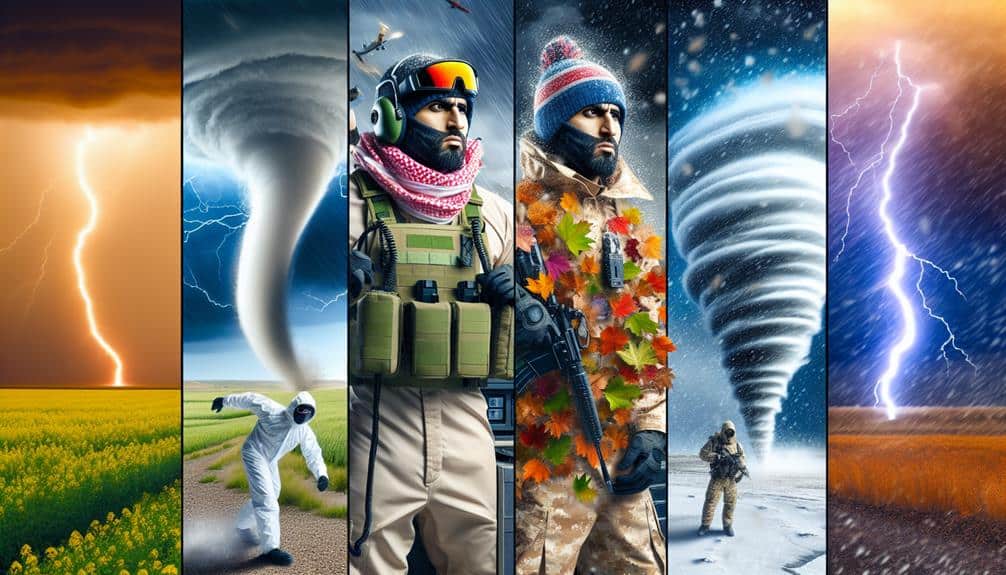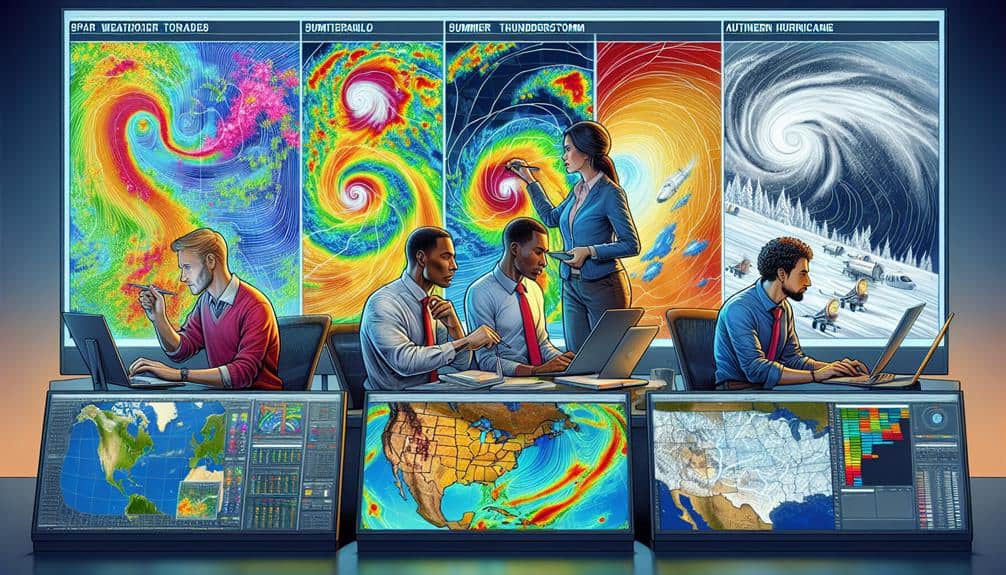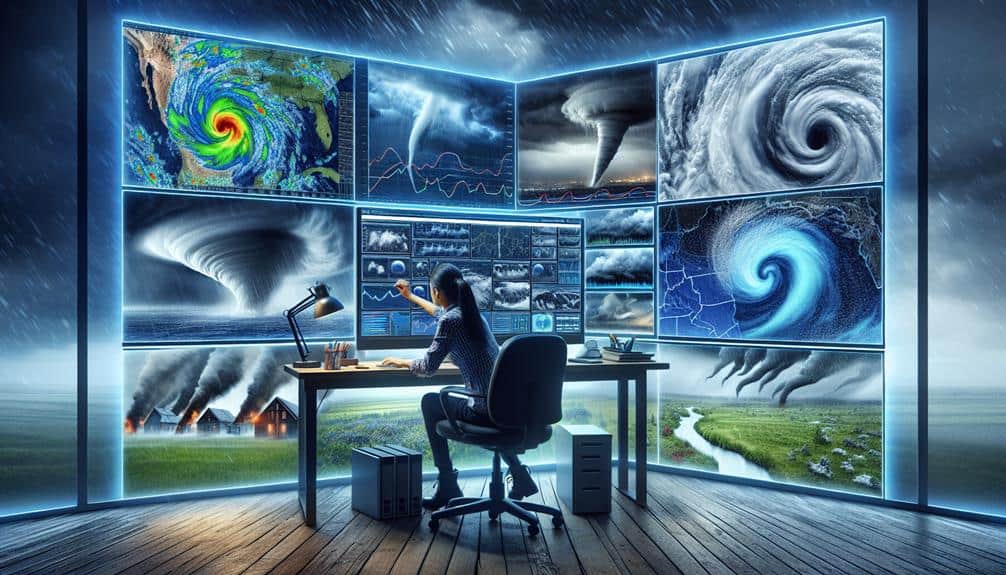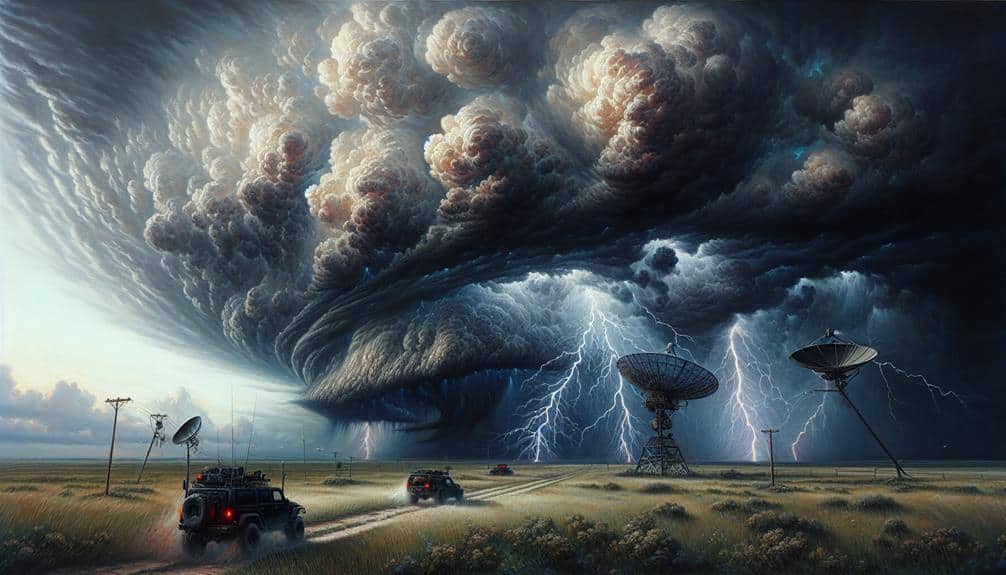When storm chasing, we must adjust to seasonal patterns and gear for conditions, from insulated winter clothing to lightweight summer attire. Essential safety includes sturdy emergency supplies and storm-specific devices like weather radars. Location is crucial; the Great Plains in spring or Northern Plains in summer maximize storm intensity encounters. We rely on high-resolution models like ECMWF to track CAPE and wind shear for best chase windows. We also analyze historical storm data to identify patterns. These steps guarantee a scientifically sound and thrilling chase, and there's more to contemplate for mastery.
Key Points
- Utilize High-Resolution Weather Models: Use ECMWF and GFS models to monitor CAPE, wind shear, and vorticity for precise storm predictions.
- Equip for Seasonal Conditions: Adapt gear to the season, such as insulated clothing for winter or lightweight, breathable attire for summer.
- Target Geographical Hotspots: Chase in Tornado Alley in late spring for supercells and the Great Plains in spring for diverse storm activities.
- Monitor Weather Radar Updates: Continuously track weather radar, especially in volatile seasons like fall, for real-time storm development and intensity.
Understanding Seasonal Patterns
To comprehend the dynamics of storm chasing, we must first analyze the seasonal weather patterns that influence storm formation. Climate changes play a pivotal role in determining storm behavior, and understanding these shifts is essential for effective storm chasing.
Seasonal variations in temperature, humidity, and atmospheric pressure directly impact the intensity and frequency of storms. For instance, spring and early summer often see an increase in severe weather events due to rising temperatures and the clash between warm, moist air from the Gulf of Mexico and cooler, dry air from the north.
Temperature variations are key drivers of storm intensity. When temperature gradients are steep, storms can rapidly intensify, leading to phenomena such as supercells and tornadoes. Data from the National Oceanic and Atmospheric Administration (NOAA) indicate that temperature anomalies can lead to more volatile storm behavior, especially during pivotal seasons like spring and fall.
Seasonal weather patterns also dictate the geographical hotspots for storm activity. In the United States, Tornado Alley experiences peak storm activity in late spring, while the Southeast sees more hurricanes during late summer and early fall. By analyzing these patterns, we can better anticipate and prepare for the challenges each season presents in our storm chasing endeavors.
Essential Gear for Each Season
Let's examine the critical gear required for each season's storm chasing.
In winter, thermal insulation and ice traction devices are paramount.
Spring demands tornado-resistant equipment and hail protection.
During summer, heat mitigation tools and hydration systems become essential for safety and efficiency.
Winter Weather Gear
Winter storm chasing requires specialized gear, including insulated clothing, waterproof boots, and high-quality gloves, to guarantee both safety and comfort in freezing conditions.
Utilizing effective layering techniques is vital to maintaining peak body temperature. We start with a moisture-wicking base layer to manage perspiration, followed by an insulating layer to retain heat, and a waterproof outer layer to shield against snow and wind. This multi-layer approach ensures we can adapt to varying conditions without compromising mobility or protection.
Winter storm driving presents unique challenges, requiring both skill and appropriate vehicle preparation. We should equip our vehicle with snow tires, chains, and emergency supplies such as blankets and a first-aid kit. Snow goggles are essential for maintaining clear visibility amidst heavy snowfall and blizzard conditions, as they prevent snow blindness and enhance contrast.
Cold weather communication can be hindered by freezing temperatures, so we need to optimize our communication devices are protected and fully charged. Using insulated cases for smartphones and two-way radios helps maintain their functionality.
Reliable communication is essential for coordinating with team members and accessing up-to-date weather data, crucial for making informed decisions during our winter storm chasing endeavors.
Spring Storm Essentials
As spring ushers in a new set of meteorological challenges, our gear must adapt to the increased likelihood of severe thunderstorms and tornadoes.
The dynamic nature of spring weather requires specialized equipment for storm photography and tornado tracking. High-resolution cameras with rapid shutter speeds are important for capturing the intricate details of storm formations. A strong tripod ensures stability during high winds, while wide-angle lenses provide expansive views of the sky.
For tornado tracking, we rely on advanced Doppler radar applications and mobile weather stations. These tools enable real-time data collection and precise location tracking, necessary for both safety and accurate documentation. A GPS-enabled anemometer measures wind speeds, offering important insights into storm intensity.
Communication is essential; two-way radios or satellite phones guarantee connectivity when cellular networks fail. We also carry portable power sources to keep our devices operational during extended chases.
Weather-resistant clothing and gear protect us from the elements, and first-aid kits are essential for addressing any injuries in remote locations.
Summer Safety Equipment
In preparation for summer storm chasing, we prioritize gear that addresses the dual threats of heat and lightning. Our summer storm gear includes lightweight, moisture-wicking clothing that helps with heat protection. We choose garments made from technical fabrics that offer UV protection and allow for best ventilation. This approach minimizes the risk of heat-related illnesses, like heat stroke or dehydration.
Effective hydration tips are essential when storm chasing in summer. We carry insulated water bottles filled with electrolyte solutions, ensuring we maintain our body's fluid balance. Portable hydration packs with built-in reservoirs offer hands-free drinking, which is essential for maintaining focus while on the move. Consistently monitoring our hydration status through urine color and volume helps us avoid dehydration.
For lightning safety, we equip our vehicles with lightning protection systems, including grounding rods and surge protectors. We use portable weather radios to stay updated on storm developments, ensuring we can take immediate shelter when necessary. Additionally, we use rubber-soled boots to reduce the risk of ground currents during lightning strikes.
Safety Precautions by Season

Storm chasers must adapt their safety protocols to the unique hazards presented by each season to minimize risk and guarantee data collection efficiency. Each season introduces specific storm seasonality and chasing hazards that we must consider.
Here's how we can stay safe throughout the year:
- Spring: Tornadoes are prevalent, so we should monitor supercell formations and stay aware of flash floods. Equip our vehicles with GPS tracking to avoid getting trapped in floodwaters.
- Summer: Heat and humidity increase the risk of heat exhaustion. We must stay hydrated and wear breathable clothing. Severe thunderstorms can produce lightning, so maintaining a safe distance from storms is imperative.
- Fall: Rapid temperature changes can lead to unpredictable storm patterns. We should check weather radar updates frequently and be prepared for sudden shifts in storm intensity.
- Winter: Snow squalls and ice storms create treacherous driving conditions. Equip our vehicles with snow tires and carry emergency supplies like blankets and non-perishable food.
Ideal Locations Throughout the Year
Identifying the ideal locations for storm chasing throughout the year requires analyzing meteorological data and understanding regional weather patterns. To maximize our storm chasing experiences, we need to target storm chasing hotspots year round, adjusting our strategies based on seasonal variations.
Spring is prime time for the Great Plains, with Tornado Alley offering unparalleled opportunities. States like Oklahoma, Kansas, and Texas become hotbeds of supercell activity due to the collision of warm, moist air from the Gulf of Mexico with cooler, dry air from the Rockies.
Summer shifts our focus northward to the Northern Plains and Upper Midwest. Here, we find frequent severe thunderstorms in states such as Nebraska, South Dakota, and Minnesota. These regions experience peak convective activity driven by warm surface temperatures and ample moisture.
Autumn pushes us back to the southern states, including Arkansas and Louisiana, where lingering warm air masses and shifting jet streams create volatile storm conditions.
Winter storm chasing requires a different approach, focusing on the Southeastern U.S. where cold fronts meet Gulf moisture, often triggering severe weather events.
Monitoring Weather Models

Analyzing real-time weather models is important for predicting storm development and planning our chase routes effectively. By leveraging advanced data interpretation techniques, we can enhance our storm prediction accuracy and make more informed decisions.
Here are four key steps to optimize our monitoring process:
- Model Selection: We should select weather models that incorporate high-resolution data and advanced algorithms. The European Centre for Medium-Range Weather Forecasts (ECMWF) and the Global Forecast System (GFS) are reliable options.
- Parameter Analysis: Focus on key parameters such as convective available potential energy (CAPE), wind shear, and vorticity. These indicators provide crucial insights into storm potential and intensity.
- Real-Time Updates: Continuous monitoring of model updates is important. Weather conditions can change rapidly, and staying updated ensures we're ready to adapt our chase plans as needed.
- Cross-Referencing Models: Cross-referencing multiple models helps validate predictions. Discrepancies between models can highlight areas of uncertainty, allowing us to approach those zones with caution and preparedness.
Timing Your Chase
To enhance our storm chasing efforts, we should focus on peak activity periods that align with seasonal weather patterns.
By analyzing meteorological data, we can identify ideal chase windows that maximize our chances of observing severe weather events.
Timing our chase with precision increases both safety and the likelihood of successful data collection.
Peak Activity Periods
Understanding the peak activity periods for severe weather phenomena is vital for effectively timing our storm chasing expeditions. By synchronizing our pursuits with these periods, we maximize our chances of encountering the most intense weather events.
Let's break down the best times for the most common severe weather phenomena:
- Spring Tornadoes: The period from March to June is prime for tornado activity, particularly in Tornado Alley. This time frame offers the highest probability for supercell formation, which is essential for tornado genesis.
- Summer Thunderstorms: From June to August, the warm, moist air masses create conditions ripe for severe thunderstorms. The convective activity during this season often leads to dramatic lightning displays and powerful downbursts.
- Fall Hurricanes: The Atlantic hurricane season peaks in September, offering an ideal window for chasing these massive storm systems. Tracking hurricanes requires careful planning due to their scale and potential for rapid intensification.
- Winter Blizzards: From December to February, the northern states experience frequent blizzards. These events are characterized by heavy snowfall and strong winds, producing whiteout conditions that are both challenging and thrilling to chase.
Seasonal Weather Patterns
Recognizing peak activity periods is only part of the equation; we must also consider how seasonal weather patterns influence the timing and location of our chases for best results. Seasonal shifts greatly impact storm formation, necessitating precise weather tracking and storm prediction to maximize our success.
In spring, the clash between warm, moist air from the Gulf of Mexico and cold, dry air from Canada creates an ideal environment for severe thunderstorms and tornadoes, especially in Tornado Alley. During summer, the jet stream moves north, and we pivot our focus to regions influenced by monsoonal flows, like the Southwestern United States, where intense thunderstorms can develop.
Autumn brings a significant impact phase where cold fronts become more frequent, and the likelihood of storms increases in the central and southern plains. Our weather tracking methods must adapt to monitor these fronts closely.
Winter storms, although less frequent, can be powerful, demanding keen attention to upper atmospheric dynamics to predict their formation accurately.
Optimal Chase Windows
Knowing the exact timing of our chase windows can significantly increase our chances of intercepting important storm events. For those of us who thrive on the freedom of the open road and the thrill of the chase, understanding seasonal nuances is essential.
Spring Timing: The peak tornado season in the U.S. occurs in spring, typically from late March to early June. This period offers the highest probability for supercell development, especially in Tornado Alley. Monitoring mesoscale convective systems and utilizing real-time radar data is necessary.
Summer Strategies: During summer, storms are often more scattered but can be more intense due to higher humidity levels. We need to adjust our strategies to account for the increased frequency of heat-driven thunderstorms. Early afternoon to early evening is typically the best chase window.
Fall Locations: As fall approaches, the primary storm locations shift southward. Targeting areas from the Southern Plains to the Gulf Coast can yield productive results. Cold fronts and remnants of tropical systems often trigger severe weather events.
Winter Chase: Winter presents unique challenges and opportunities. While less frequent, winter storms can be particularly severe, often driven by strong upper-level jet streams. Focusing on areas with significant temperature gradients can help pinpoint potential storm development zones.
Analyzing Past Storm Data

To analyze past storm data effectively, we'll investigate historical records, satellite imagery, and meteorological statistics to identify patterns and anomalies. By focusing on storm tracking, we can establish a clearer picture of storm paths and their frequency across different seasons. Historical records offer valuable insights into the timing and locations of past storms, which can enhance our weather analysis.
We should utilize satellite imagery to visualize storm development and movement over time. This helps us understand the evolution of storm systems and predict potential future behavior. Meteorological statistics, such as wind speed, temperature, and pressure data, enable us to quantify the severity and impact of past storms.
Combining these data sources allows us to detect recurring patterns and seasonal variances. For instance, certain regions may exhibit higher storm activity during specific months, guiding our storm chasing strategies. By meticulously analyzing this data, we enhance our ability to forecast storm occurrences and optimize chase windows.
Ultimately, a robust understanding of past storm data empowers us to anticipate weather phenomena with greater accuracy and confidence, providing the freedom to chase storms more safely and effectively. Let's leverage this data-driven approach to elevate our storm chasing endeavors.
Frequently Asked Questions
How Do Storm Chasers Contribute to Meteorological Research?
We collect valuable meteorological data during storms, which leads to research advancements. By analyzing these data, we improve predictive models and enhance our understanding of severe weather patterns, ultimately contributing to greater scientific freedom and safety.
What Are Some Common Myths About Storm Chasing?
Ever wondered if storm chasing is as dangerous as it seems? Media sensationalism often exaggerates the risk. While there's undeniable excitement, safety protocols and scientific data minimize hazards, making it less perilous than perceived.
How Can One Get Started in Storm Chasing as a Hobby?
To get started in storm chasing, we'll need reliable storm chasing gear and a solid understanding of weather patterns. Join local meteorological groups, study atmospheric data, and invest in safety equipment to guarantee accurate, thrilling experiences.
Are There Any Famous Storm Chasers to Follow for Inspiration?
Coincidentally, we can follow reputable sources like Reed Timmer and Jim Cantore for inspiration. They prioritize storm data, utilize precise safety precautions, and share invaluable insights, empowering us to chase storms while ensuring our safety.
What Are the Ethical Considerations in Storm Chasing?
When considering the ethical aspects of storm chasing, we must prioritize safety precautions and minimize our environmental impact. We need to respect local communities, avoid interfering with emergency services, and employ sustainable practices during our expeditions.


